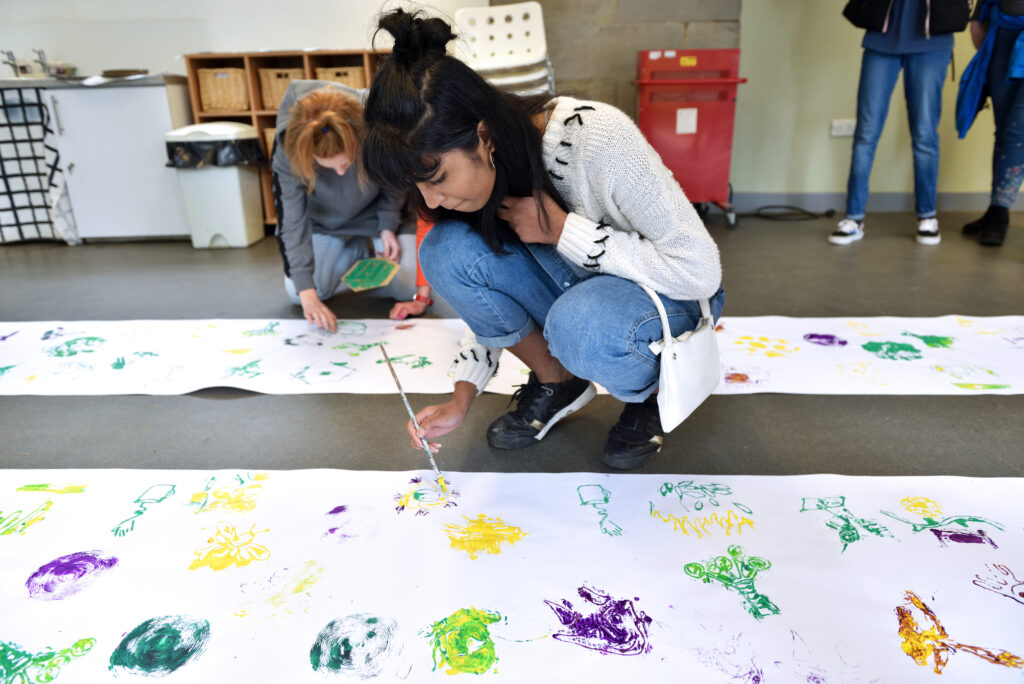Authored by Beth Booth

The Layering Method
Presenting prompts in “layers” helps to support a range of processing speeds and confidence levels within your audience. This approach avoids anybody getting left behind without putting the onus on participants to ask for clarification when they may not feel confident doing so.
The first layer is the prompt in a simple, open-ended form. (For example: we’re going to write a poem about joy.) The second layer consists of possible approaches to the prompt – how someone might go about completing it. (For example: you could start by making a mind map of images and words you associate with joy; you could write a prose poem if you’re less confident with traditional poetry.) The third layer is made up of concrete content ideas for the prompt. This could be a list of questions, sentence starters, or more specific mini-prompts. (For example: what does joy feel like in your body? What colour is joy to you? What scent or sound?) Inviting group members to make a start at whatever layer they feel confident doing so – so long as the task isn’t disruptive to those around them! – means we can cater to those who might struggle without asking for more time than we need to from people who immediately have ideas.
(It might be nice to have an image for this, just of three layers labelled “Prompt”, “Possible approaches” and “Content ideas” maybe?)
Taking the Temperature of the Room
Having an open line of communication with participants about their needs and preferences is an important part of delivering accessible sessions. We should be proactive about asking questions and acting on their answers. We want to ensure participants are informed (on the room or virtual space they’ll be occupying, the content they’ll be engaging with, and what they’ll be expected to do) and that they feel able to manage their own experience. Sending a session overview out ahead of time can be very powerful in this regard, as can tailoring our content to the group’s interests and opinions where possible.
Any given audience or participant will have a different opinion on how they want a session to operate. They might prefer, for instance:
- working in silence or with music
- raising a hand to be called on or simply speaking up with comments
- a warmer/cooler/brighter/dimmer room
- several breaks or none at all
- sitting all at one big table or at several smaller ones
While we as facilitators can’t please everybody, we can accommodate everybody to the best of our ability by acting on the majority opinion of the group (or on the opinions of those who have the most significant preference or need) while also inviting participants to use individual strategies to make themselves comfortable. This could look like:
- providing fidget toys for those who would like them
- providing breakout spaces
- inviting participants to take extra breaks when they need to
- inviting participants to turn off their camera in an online session when they need a moment
- making sure we call on participants to speak who have expressed a struggle with speaking up
- encouraging participants to bring headphones or layers with them to manage their own sonic space and temperature
- allowing participants to eat, drink, doodle, or chew gum quietly
- providing varied seating and inviting participants to stand or move their bodies when needed
- any other strategies which apply to our audience’s needs!
Letting Go of Ego
Facilitating can be anxiety-inducing, as can attending sessions as a disabled or neurodivergent individual. To help us all feel more comfortable, we can make an effort to actively let go of the part of us which wants to be perfect and get everything right for everybody all the time. Flexibility is a huge skill in facilitation and we’re constantly learning as we’re educating. Being open to answering questions, reconsidering our plans, and taking feedback on board benefits both our participants and us. In practice, this might look like:
- Being receptive to requests for clarification
- Being open to providing alternative spaces, activities and prompts when needed, and not clinging to our original plans at participants’ expense
- Recognising that concerns being raised does not reflect poorly on us, but it is our responsibility to take action on them
- Not taking distraction or low energy levels among participants personally, and having strategies for managing these things when they arise in a positive, kind way
- Recognising that participants engage and regulate differently, and that fiddling, lack of eye contact, or somebody struggling to understand are not signs of disrespect
Confident facilitators can celebrate participant behaviour or feedback which draws their attention to the fact that something might not be working, and do so without giving themselves a hard time for not always being able to anticipate every problem.

Apply Your Thinking:
Write or record 3-5 key points that you will use in the future
This Sprint has been full of tips and approaches for making people feel welcome, accommodated, and like their needs are being met to support learning. The previous Sprint shared ways to make sessions accessible. Now we want you to make a list of what you will take forward with you, try out and use to support your future workshop participants. You might use some of these ‘tactics’ or make up your own! Use this list in your future lesson planning, check in with yourself to ensure you are doing these things when you deliver.






